glove box NISSAN MAXIMA 2021 Owner´s Manual
[x] Cancel search | Manufacturer: NISSAN, Model Year: 2021, Model line: MAXIMA, Model: NISSAN MAXIMA 2021Pages: 476, PDF Size: 3.32 MB
Page 13 of 476
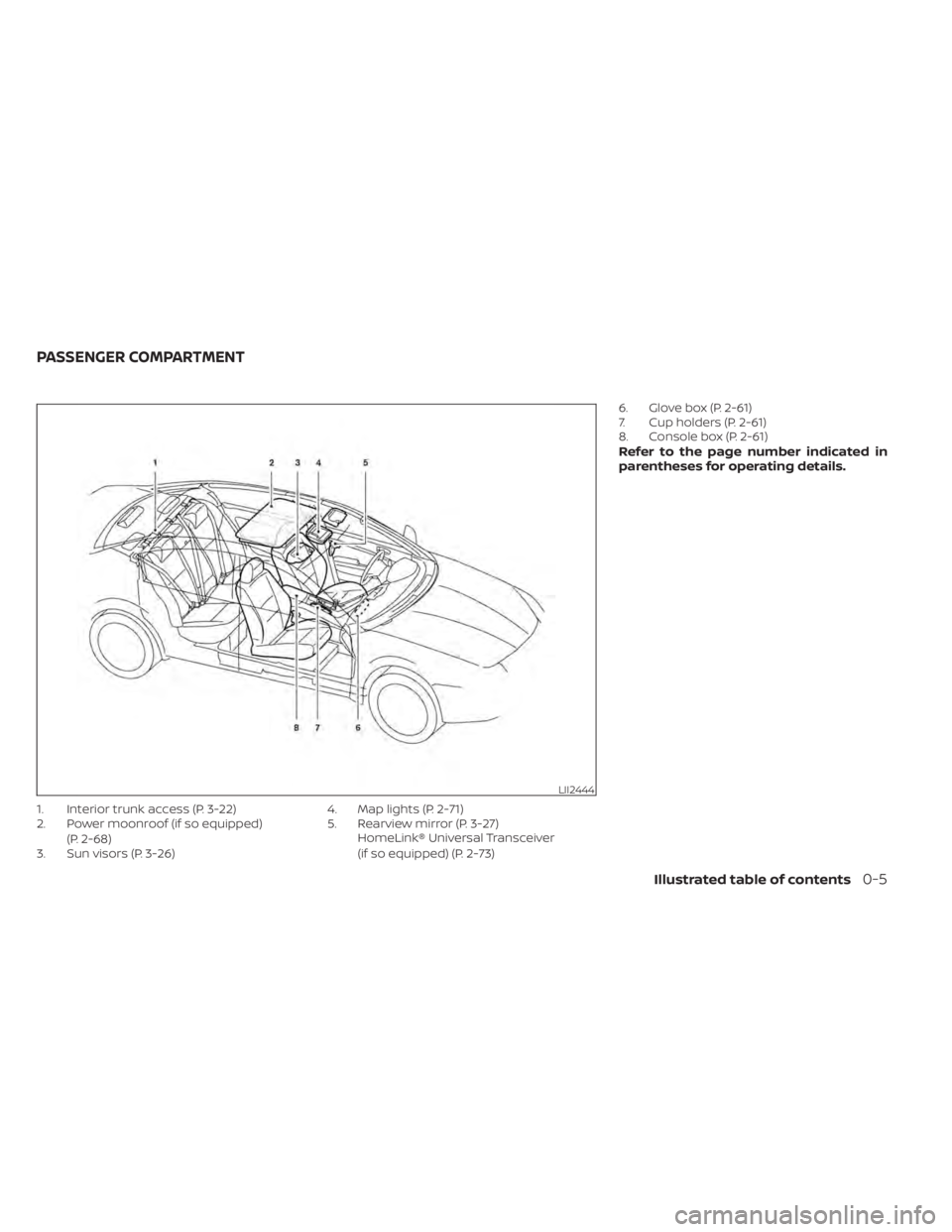
1. Interior trunk access (P. 3-22)
2. Power moonroof (if so equipped)(P. 2-68)
3. Sun visors (P. 3-26) 4. Map lights (P. 2-71)
5. Rearview mirror (P. 3-27)
HomeLink® Universal Transceiver
(if so equipped) (P. 2-73) 6. Glove box (P. 2-61)
7. Cup holders (P. 2-61)
8. Console box (P. 2-61)
Refer to the page number indicated in
parentheses for operating details.
LII2444
PASSENGER COMPARTMENT
Illustrated table of contents0-5
Page 14 of 476
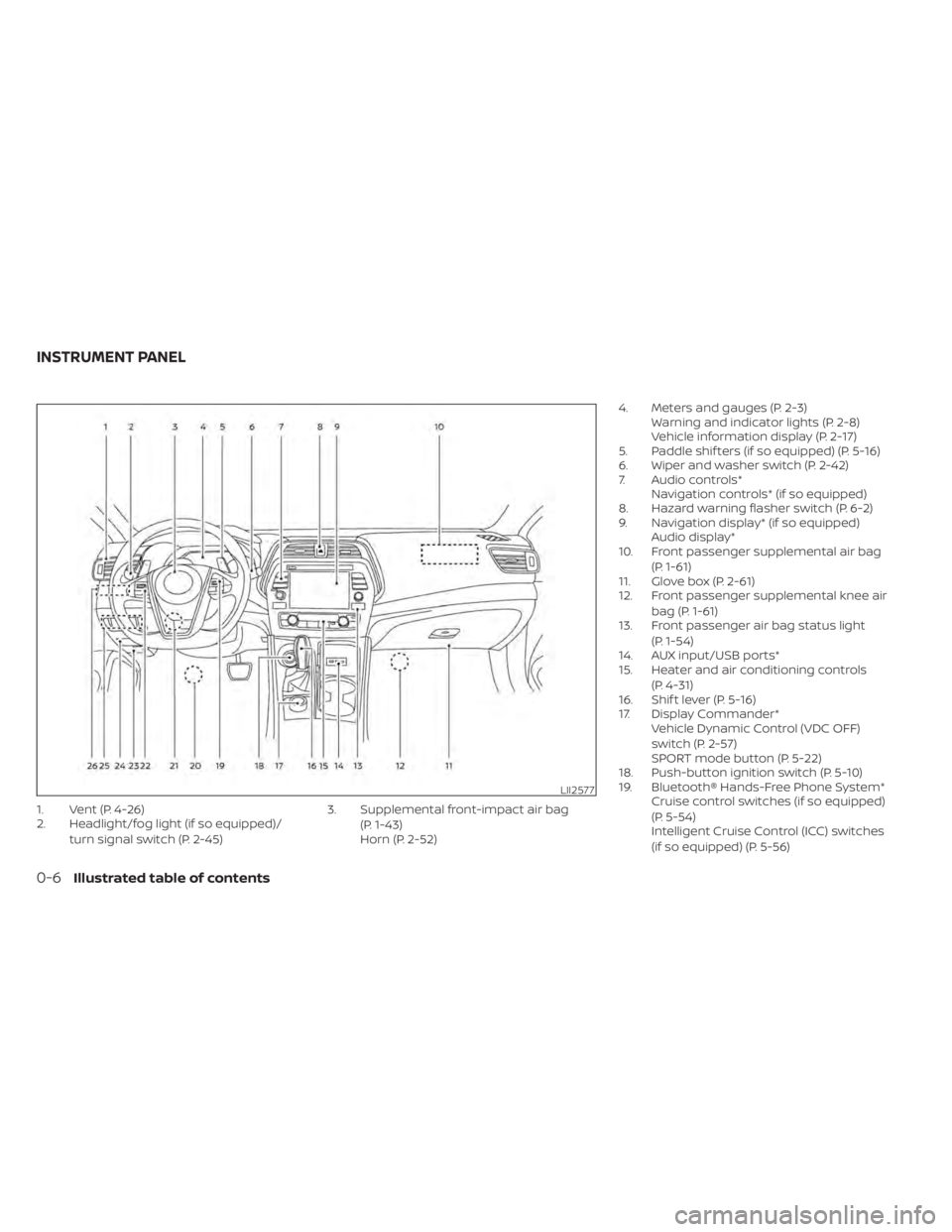
1. Vent (P. 4-26)
2. Headlight/fog light (if so equipped)/turn signal switch (P. 2-45) 3. Supplemental front-impact air bag
(P. 1-43)
Horn (P. 2-52) 4. Meters and gauges (P. 2-3)
Warning and indicator lights (P. 2-8)
Vehicle information display (P. 2-17)
5. Paddle shif ters (if so equipped) (P. 5-16)
6. Wiper and washer switch (P. 2-42)
7. Audio controls* Navigation controls* (if so equipped)
8. Hazard warning flasher switch (P. 6-2)
9. Navigation display* (if so equipped) Audio display*
10. Front passenger supplemental air bag
(P. 1-61)
11. Glove box (P. 2-61)
12. Front passenger supplemental knee air
bag (P. 1-61)
13. Front passenger air bag status light
(P. 1-54)
14. AUX input/USB ports*
15. Heater and air conditioning controls
(P. 4-31)
16. Shif t lever (P. 5-16)
17. Display Commander* Vehicle Dynamic Control (VDC OFF)
switch (P. 2-57)
SPORT mode button (P. 5-22)
18. Push-button ignition switch (P. 5-10)
19. Bluetooth® Hands-Free Phone System* Cruise control switches (if so equipped)
(P. 5-54)
Intelligent Cruise Control (ICC) switches
(if so equipped) (P. 5-56)
LII2577
INSTRUMENT PANEL
0-6Illustrated table of contents
Page 70 of 476
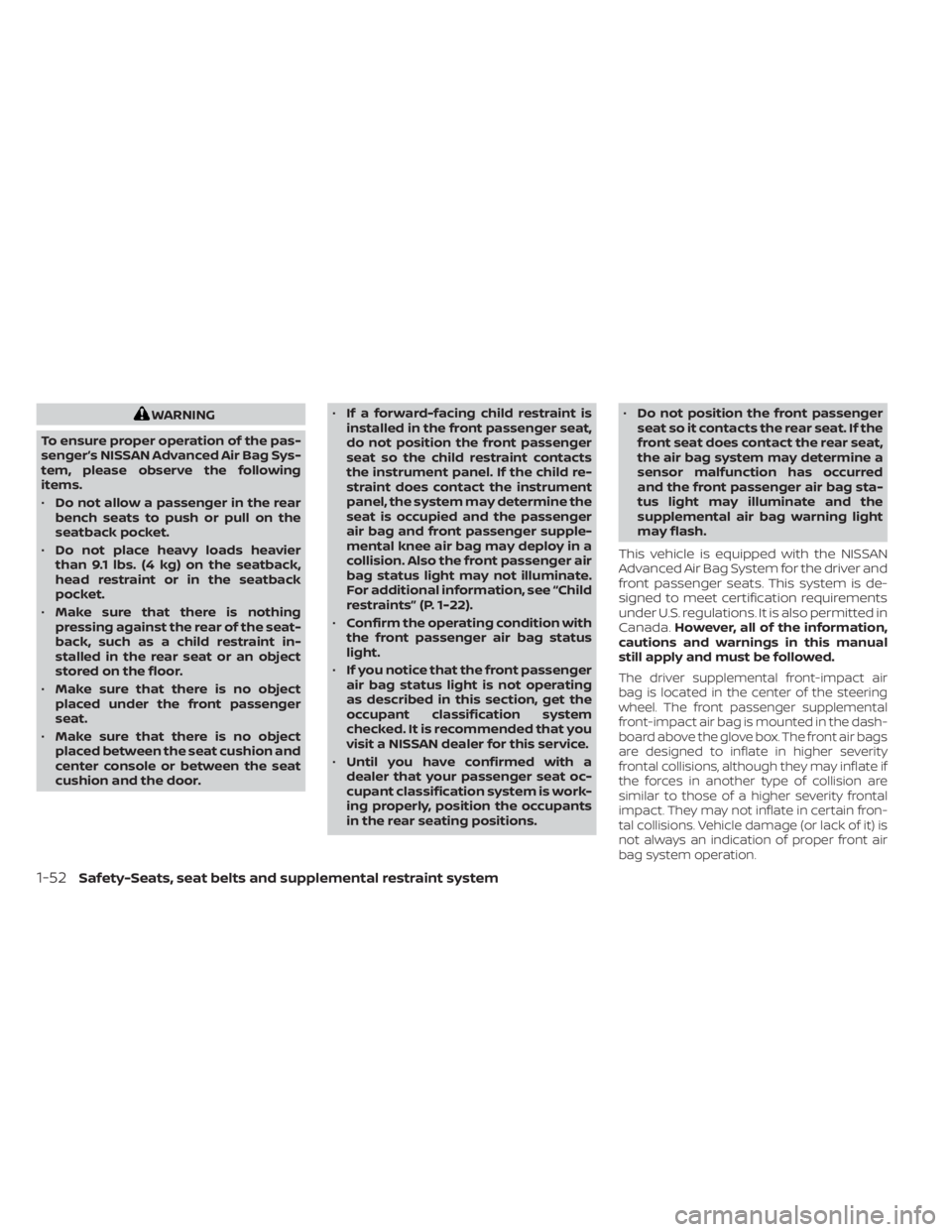
WARNING
To ensure proper operation of the pas-
senger’s NISSAN Advanced Air Bag Sys-
tem, please observe the following
items.
• Do not allow a passenger in the rear
bench seats to push or pull on the
seatback pocket.
• Do not place heavy loads heavier
than 9.1 lbs. (4 kg) on the seatback,
head restraint or in the seatback
pocket.
• Make sure that there is nothing
pressing against the rear of the seat-
back, such as a child restraint in-
stalled in the rear seat or an object
stored on the floor.
• Make sure that there is no object
placed under the front passenger
seat.
• Make sure that there is no object
placed between the seat cushion and
center console or between the seat
cushion and the door. •
If a forward-facing child restraint is
installed in the front passenger seat,
do not position the front passenger
seat so the child restraint contacts
the instrument panel. If the child re-
straint does contact the instrument
panel, the system may determine the
seat is occupied and the passenger
air bag and front passenger supple-
mental knee air bag may deploy in a
collision. Also the front passenger air
bag status light may not illuminate.
For additional information, see “Child
restraints” (P. 1-22).
• Confirm the operating condition with
the front passenger air bag status
light.
• If you notice that the front passenger
air bag status light is not operating
as described in this section, get the
occupant classification system
checked. It is recommended that you
visit a NISSAN dealer for this service.
• Until you have confirmed with a
dealer that your passenger seat oc-
cupant classification system is work-
ing properly, position the occupants
in the rear seating positions. •
Do not position the front passenger
seat so it contacts the rear seat. If the
front seat does contact the rear seat,
the air bag system may determine a
sensor malfunction has occurred
and the front passenger air bag sta-
tus light may illuminate and the
supplemental air bag warning light
may flash.
This vehicle is equipped with the NISSAN
Advanced Air Bag System for the driver and
front passenger seats. This system is de-
signed to meet certification requirements
under U.S. regulations. It is also permitted in
Canada. However, all of the information,
cautions and warnings in this manual
still apply and must be followed.
The driver supplemental front-impact air
bag is located in the center of the steering
wheel. The front passenger supplemental
front-impact air bag is mounted in the dash-
board above the glove box. The front air bags
are designed to inflate in higher severity
frontal collisions, although they may inflate if
the forces in another type of collision are
similar to those of a higher severity frontal
impact. They may not inflate in certain fron-
tal collisions. Vehicle damage (or lack of it) is
not always an indication of proper front air
bag system operation.
1-52Safety-Seats, seat belts and supplemental restraint system
Page 87 of 476
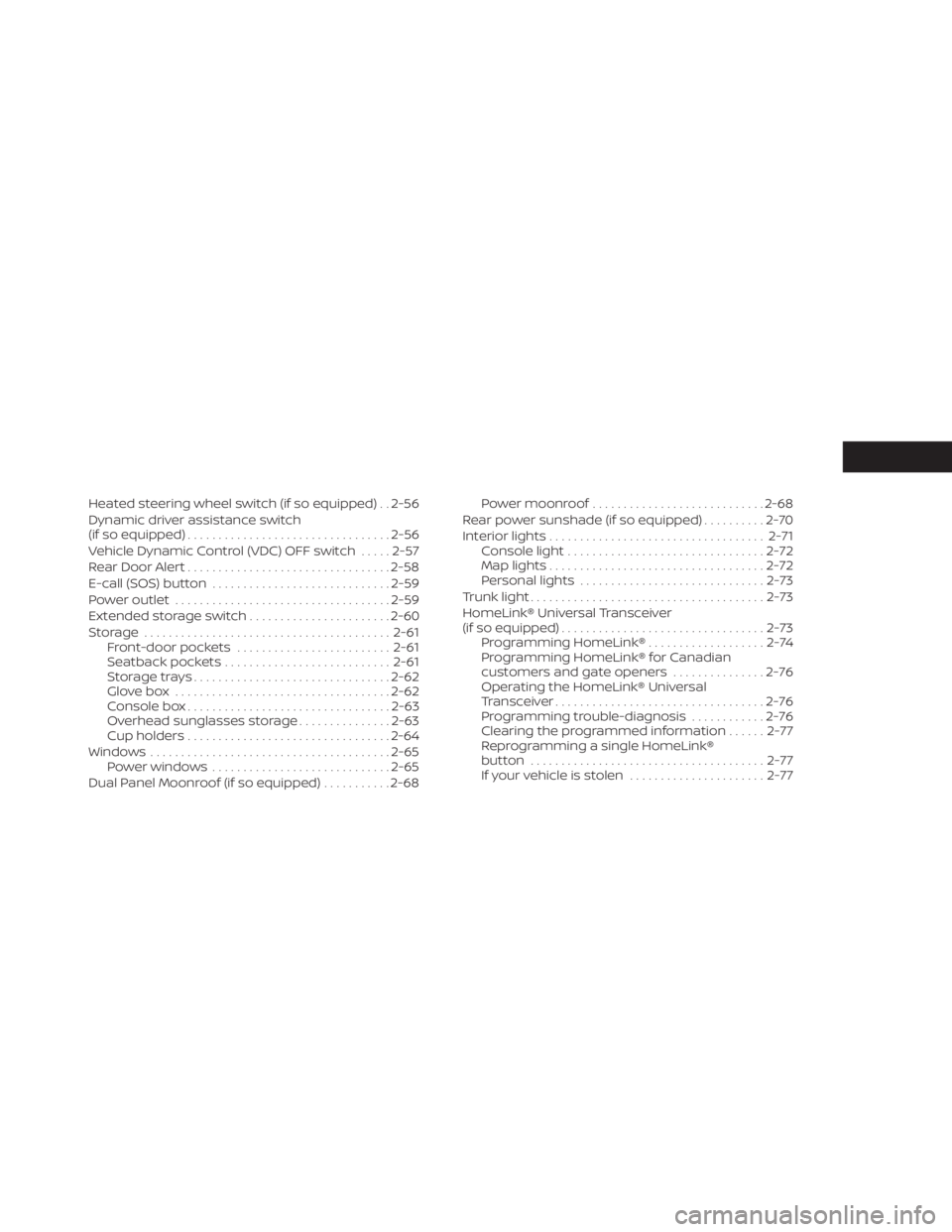
Heated steering wheel switch (if so equipped) . . 2-56
Dynamic driver assistance switch
(if so equipped)................................. 2-56
Vehicle Dynamic Control (VDC) OFF switch .....2-57
Rear Door Alert ................................. 2-58
E-call (SOS) button ............................. 2-59
Power outlet ................................... 2-59
Extended storage switch .......................2-60
Storage ........................................ 2-61
Front-door pockets ......................... 2-61
Seatback pockets ........................... 2-61
Storagetrays................................ 2-62
Glovebox ................................... 2-62
Console box ................................. 2-63
Overhead sunglasses storage ...............2-63
Cup holders ................................. 2-64
Windows ....................................... 2-65
Power windows ............................. 2-65
Dual Panel Moonroof (if so equipped) ...........2-68 Power moonroof
............................ 2-68
Rear power sunshade (if so equipped) ..........2-70
Interior lights ................................... 2-71
Console light ................................ 2-72
Map lights ................................... 2-72
Personal lights .............................. 2-73
Trunk light ...................................... 2-73
HomeLink® Universal Transceiver
(if so equipped) ................................. 2-73
Programming HomeLink® ...................2-74
Programming HomeLink® for Canadian
customers and gate openers ...............2-76
Operating the HomeLink® Universal
Transceiver .................................. 2-76
Programming trouble-diagnosis ............2-76
Clearing the programmed information ......2-77
Reprogramming a single HomeLink®
button ...................................... 2-77
If your vehicle is stolen ......................2-77
Page 88 of 476
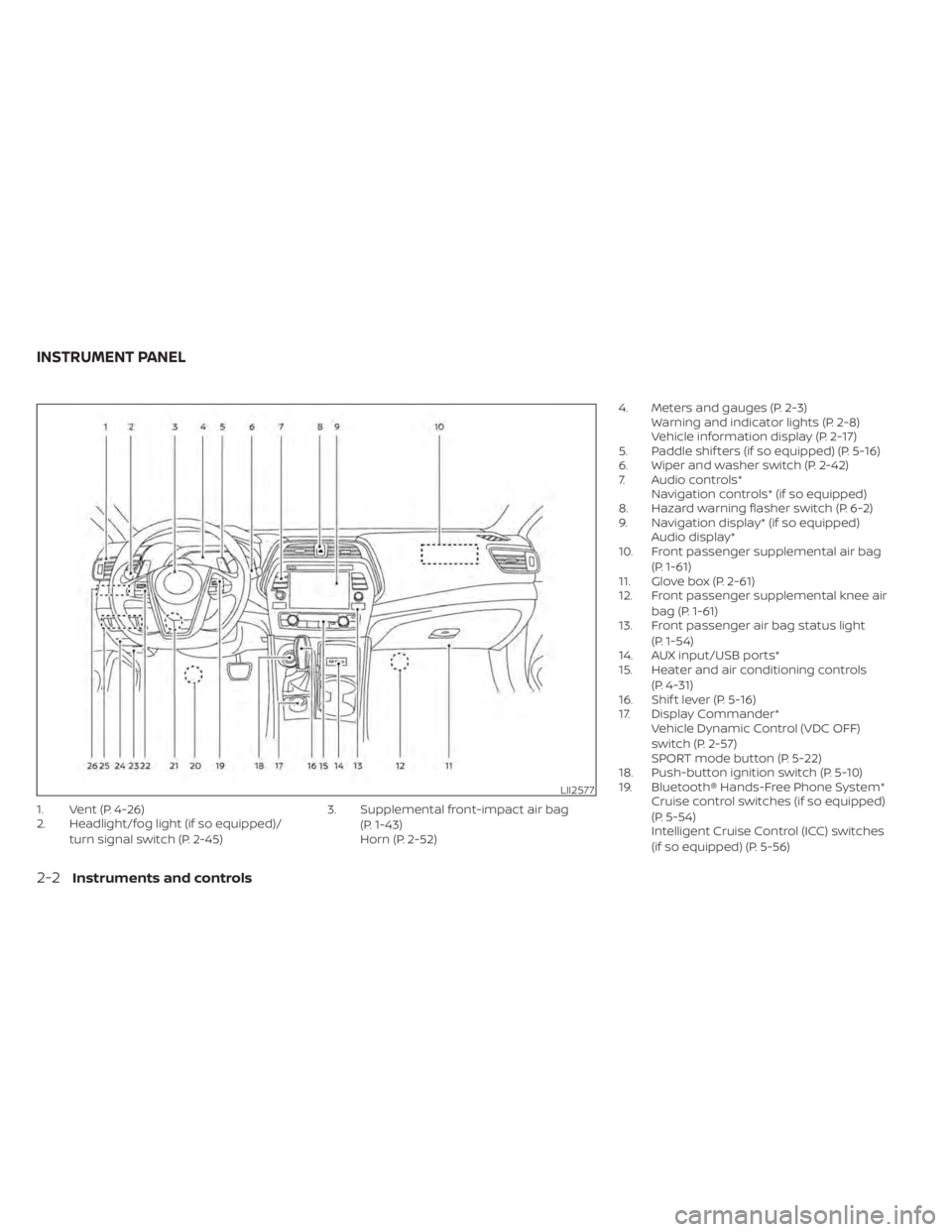
1. Vent (P. 4-26)
2. Headlight/fog light (if so equipped)/turn signal switch (P. 2-45) 3. Supplemental front-impact air bag
(P. 1-43)
Horn (P. 2-52) 4. Meters and gauges (P. 2-3)
Warning and indicator lights (P. 2-8)
Vehicle information display (P. 2-17)
5. Paddle shif ters (if so equipped) (P. 5-16)
6. Wiper and washer switch (P. 2-42)
7. Audio controls* Navigation controls* (if so equipped)
8. Hazard warning flasher switch (P. 6-2)
9. Navigation display* (if so equipped) Audio display*
10. Front passenger supplemental air bag
(P. 1-61)
11. Glove box (P. 2-61)
12. Front passenger supplemental knee air
bag (P. 1-61)
13. Front passenger air bag status light
(P. 1-54)
14. AUX input/USB ports*
15. Heater and air conditioning controls
(P. 4-31)
16. Shif t lever (P. 5-16)
17. Display Commander* Vehicle Dynamic Control (VDC OFF)
switch (P. 2-57)
SPORT mode button (P. 5-22)
18. Push-button ignition switch (P. 5-10)
19. Bluetooth® Hands-Free Phone System* Cruise control switches (if so equipped)
(P. 5-54)
Intelligent Cruise Control (ICC) switches
(if so equipped) (P. 5-56)
LII2577
INSTRUMENT PANEL
2-2Instruments and controls
Page 148 of 476
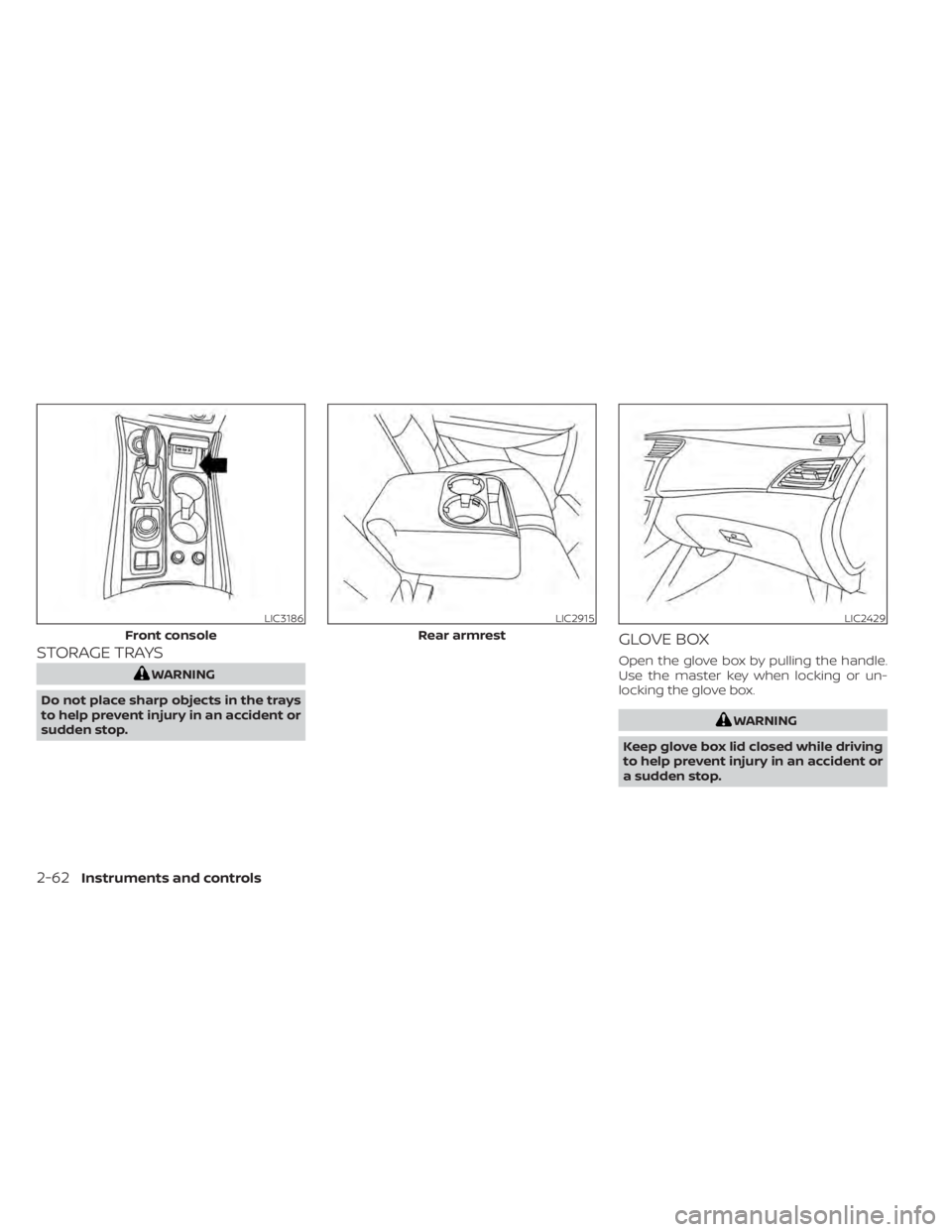
STORAGE TRAYS
WARNING
Do not place sharp objects in the trays
to help prevent injury in an accident or
sudden stop.
GLOVE BOX
Open the glove box by pulling the handle.
Use the master key when locking or un-
locking the glove box.
WARNING
Keep glove box lid closed while driving
to help prevent injury in an accident or
a sudden stop.
LIC3186
Front console
LIC2915
Rear armrest
LIC2429
2-62Instruments and controls
Page 167 of 476
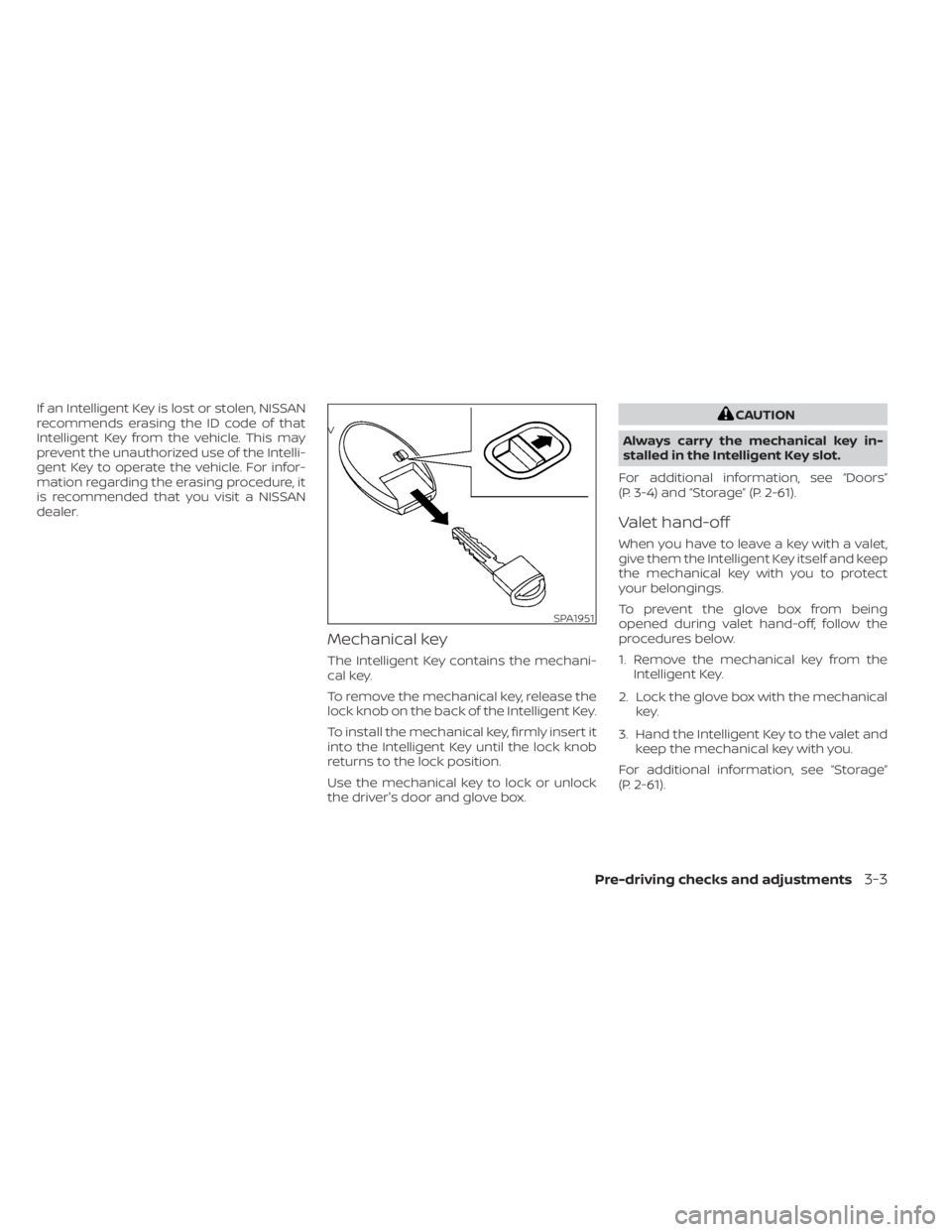
If an Intelligent Key is lost or stolen, NISSAN
recommends erasing the ID code of that
Intelligent Key from the vehicle. This may
prevent the unauthorized use of the Intelli-
gent Key to operate the vehicle. For infor-
mation regarding the erasing procedure, it
is recommended that you visit a NISSAN
dealer.
Mechanical key
The Intelligent Key contains the mechani-
cal key.
To remove the mechanical key, release the
lock knob on the back of the Intelligent Key.
To install the mechanical key, firmly insert it
into the Intelligent Key until the lock knob
returns to the lock position.
Use the mechanical key to lock or unlock
the driver's door and glove box.
CAUTION
Always carry the mechanical key in-
stalled in the Intelligent Key slot.
For additional information, see “Doors”
(P. 3-4) and “Storage” (P. 2-61).
Valet hand-off
When you have to leave a key with a valet,
give them the Intelligent Key itself and keep
the mechanical key with you to protect
your belongings.
To prevent the glove box from being
opened during valet hand-off, follow the
procedures below.
1. Remove the mechanical key from the Intelligent Key.
2. Lock the glove box with the mechanical key.
3. Hand the Intelligent Key to the valet and keep the mechanical key with you.
For additional information, see “Storage”
(P. 2-61).
SPA1951
v
Pre-driving checks and adjustments3-3
Page 174 of 476
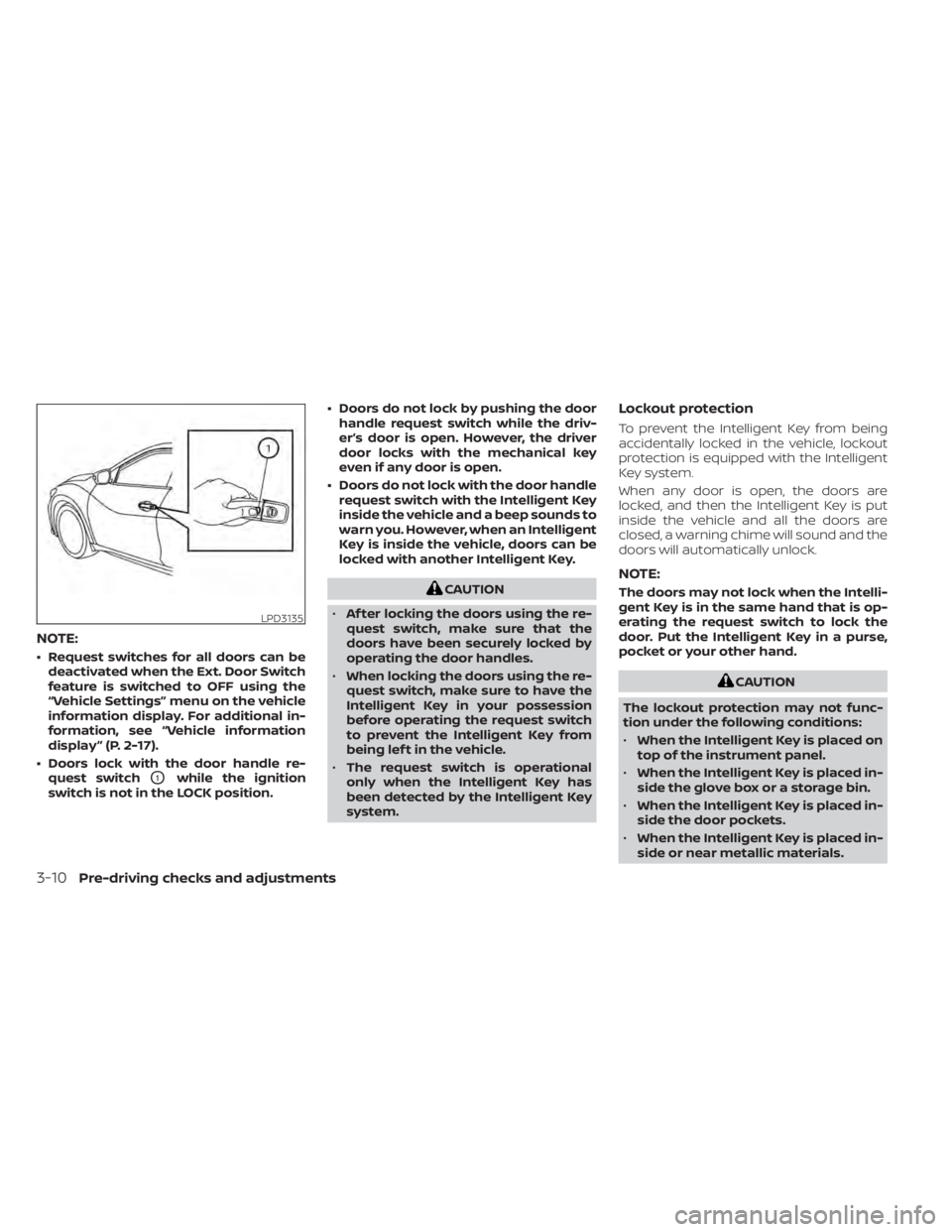
NOTE:
• Request switches for all doors can bedeactivated when the Ext. Door Switch
feature is switched to OFF using the
“Vehicle Settings” menu on the vehicle
information display. For additional in-
formation, see “Vehicle information
display ” (P. 2-17).
• Doors lock with the door handle re- quest switch
O1while the ignition
switch is not in the LOCK position. • Doors do not lock by pushing the door
handle request switch while the driv-
er’s door is open. However, the driver
door locks with the mechanical key
even if any door is open.
• Doors do not lock with the door handle request switch with the Intelligent Key
inside the vehicle and a beep sounds to
warn you. However, when an Intelligent
Key is inside the vehicle, doors can be
locked with another Intelligent Key.
CAUTION
• Af ter locking the doors using the re-
quest switch, make sure that the
doors have been securely locked by
operating the door handles.
• When locking the doors using the re-
quest switch, make sure to have the
Intelligent Key in your possession
before operating the request switch
to prevent the Intelligent Key from
being lef t in the vehicle.
• The request switch is operational
only when the Intelligent Key has
been detected by the Intelligent Key
system.
Lockout protection
To prevent the Intelligent Key from being
accidentally locked in the vehicle, lockout
protection is equipped with the Intelligent
Key system.
When any door is open, the doors are
locked, and then the Intelligent Key is put
inside the vehicle and all the doors are
closed, a warning chime will sound and the
doors will automatically unlock.
NOTE:
The doors may not lock when the Intelli-
gent Key is in the same hand that is op-
erating the request switch to lock the
door. Put the Intelligent Key in a purse,
pocket or your other hand.
CAUTION
The lockout protection may not func-
tion under the following conditions:
• When the Intelligent Key is placed on
top of the instrument panel.
• When the Intelligent Key is placed in-
side the glove box or a storage bin.
• When the Intelligent Key is placed in-
side the door pockets.
• When the Intelligent Key is placed in-
side or near metallic materials.
LPD3135
3-10Pre-driving checks and adjustments
Page 242 of 476

If the Intelligent Key is within the operating
range, it is possible for anyone, even some-
one who does not carry the Intelligent Key,
to push the ignition switch to start the
engine.
The operating range of the engine start
function is inside of the vehicle
O1.
• The luggage area is not included in the operating range, but the Intelligent Key
may function.
• If the Intelligent Key is placed on the in- strument panel, inside the glove box,
storage bin or door pocket, the Intelligent
Key may not function.
• If the Intelligent Key is placed near the door or window outside the vehicle, the
Intelligent Key may function.
PUSH-BUTTON IGNITION SWITCH
POSITIONS
LOCK (Normal parking position)
The ignition switch can only be locked in
this position.
The ignition switch will be unlocked when it
is pushed to the ACC position while carry-
ing the Intelligent Key. The ignition switch will lock when any door
is opened or closed with the ignition
switched off.
ACC (Accessories)
This position activates electrical accesso-
ries, such as the radio, when the engine is
not running.
ACC has a battery saver feature that will
place the ignition switch in the OFF position
af ter a period of time under the following
conditions:
• All doors are closed.
• The shif t lever is in P (Park).
• The hazard lamps are off.
• The turn signals are off.
The battery saver feature will be canceled if
any of the following occur:
• Any door is opened.
• The shif t lever is moved out of P (Park).
• The ignition switch changes position.
• The hazard lamps are turned on.
ON (Normal operating position)
This position turns on the ignition system
and electrical accessories.
ON has a battery saver feature that will
place the ignition switch in the OFF posi-
tion, if the vehicle is not running, af ter some
time under the following conditions:
• All doors are closed.
• The shif t lever is in P (Park).
• The hazard lamps are off.
• The turn signals are off.
The battery saver feature will be canceled if
any of the following occur:
• Any door is opened.
• The shif t lever is moved out of the P (Park)
position.
• The ignition switch changes position.
• The hazard lamps are turned on.
• The turn signals are turned on.
CAUTION
Do not leave the vehicle with the igni-
tion switch in the ACC or ON position
when the engine is not running for an
extended period. This can discharge
the battery.
5-12Starting and driving
Page 393 of 476
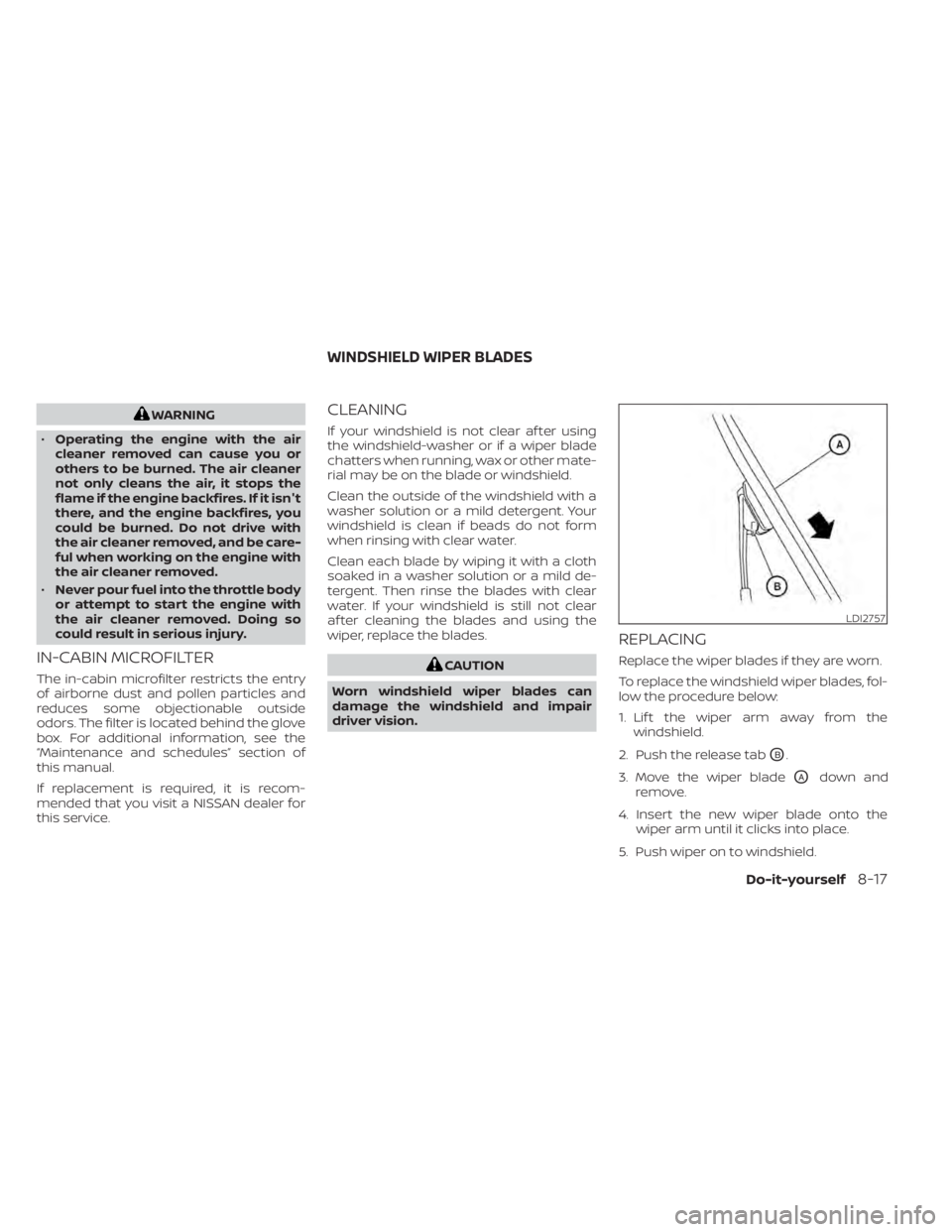
WARNING
• Operating the engine with the air
cleaner removed can cause you or
others to be burned. The air cleaner
not only cleans the air, it stops the
flame if the engine backfires. If it isn't
there, and the engine backfires, you
could be burned. Do not drive with
the air cleaner removed, and be care-
ful when working on the engine with
the air cleaner removed.
• Never pour fuel into the throttle body
or attempt to start the engine with
the air cleaner removed. Doing so
could result in serious injury.
IN-CABIN MICROFILTER
The in-cabin microfilter restricts the entry
of airborne dust and pollen particles and
reduces some objectionable outside
odors. The filter is located behind the glove
box. For additional information, see the
“Maintenance and schedules” section of
this manual.
If replacement is required, it is recom-
mended that you visit a NISSAN dealer for
this service.
CLEANING
If your windshield is not clear af ter using
the windshield-washer or if a wiper blade
chatters when running, wax or other mate-
rial may be on the blade or windshield.
Clean the outside of the windshield with a
washer solution or a mild detergent. Your
windshield is clean if beads do not form
when rinsing with clear water.
Clean each blade by wiping it with a cloth
soaked in a washer solution or a mild de-
tergent. Then rinse the blades with clear
water. If your windshield is still not clear
af ter cleaning the blades and using the
wiper, replace the blades.
CAUTION
Worn windshield wiper blades can
damage the windshield and impair
driver vision.
REPLACING
Replace the wiper blades if they are worn.
To replace the windshield wiper blades, fol-
low the procedure below:
1. Lif t the wiper arm away from the windshield.
2. Push the release tab
OB.
3. Move the wiper blade
OAdown and
remove.
4. Insert the new wiper blade onto the wiper arm until it clicks into place.
5. Push wiper on to windshield.
LDI2757
WINDSHIELD WIPER BLADES
Do-it-yourself8-17